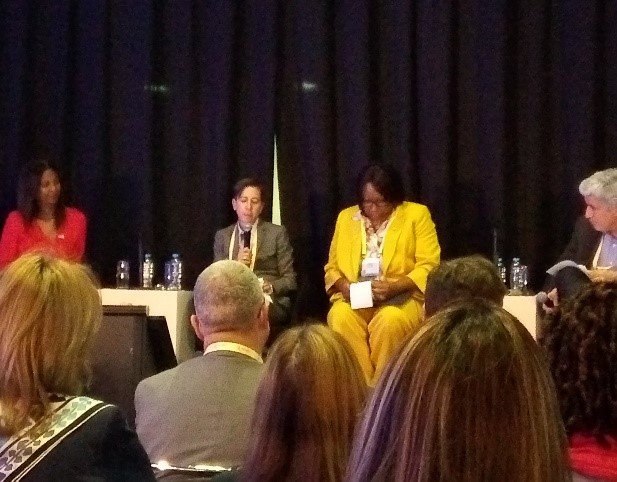
First Lady of Belize calls for empowerment of women and girls
Image: First Lady, Kim Simplis-Barrow, first from left
First Lady of Belize, Kim Simplis-Barrow, called for empowerment of women and girls as a priority for achieving universal health coverage and HIV targets. The First Lady was speaking at the Global Fund Dialogue among leaders on mobilizing and promoting better use of HIV and health investment convened at the 10th International AIDS Society Conference on HIV Science which is being held in Mexico City, Mexico from 20-24 July.
Ms Simplis-Barrow emphasized that there is a critical need to address human rights and stigma and discrimination, gender inequality, violence against women and girls and poverty that place them at higher risk. All these issues serve as barriers to access to services. She lauded PANCAP and other partners’ support to Belize in the development of an Anti-Discrimination Legislation. She noted that Spouses of Caribbean Leaders have influence in bringing about an enabling environment.
The First Lady also called for a successful Sixth Replenishment of the Global Fund, which she believes would allow for the global financing mechanism model to continue. She reminded the audience that the Global Fund’s model is client-centred and addresses the holistic health needs of individuals and communities.
WHAT IS PANCAP?
PANCAP is a Caribbean regional partnership of governments, regional civil society organisations, regional institutions and organisations, bilateral and multilateral agencies and contributing donor partners established on 14 February 2001. PANCAP provides a structured and unified approach to the Caribbean’s response to the HIV epidemic, and coordinates the response through the Caribbean Regional Strategic Framework on HIV and AIDS to maximise efficient use of resources and increase impact, mobilise resources and build the capacity of partners.
What are the Global AIDS Strategy 2021–2026 targets and commitments?
If targets and commitments in the strategy are achieved:
- The number of people who newly acquire HIV will decrease from 1.7 million in 2019 to less than 370 000 by 2025
- The number of people dying from AIDS-related illnesses will decrease from 690 000 in 2019 to less than 250 000 in 2025.
- The goal of eliminating new HIV infections among children will see the number of new HIV infections drop from 150,000 in 2019 to less than 22,000 in 2025.
What are the 95-95-95 Targets for ending AIDS?
- 95% of People Living with HIV know their HIV status;
- 95% of people who know their status on treatment; and
- 95% of people on treatment with suppressed viral loads.
HELPFUL LINKS:
Global AIDS Strategy 2021–2026, End Inequalities, End AIDS
https://pancap.org/pancap-documents/global-aids-strategy-2021-2026-end-inequalities-end-aids/
Caribbean Regional Strategic Framework on HIV and AIDS (CRSF) 2019-2025
https://pancap.org/pancap-documents/caribbean-regional-strategic-framework-2019-2025/
